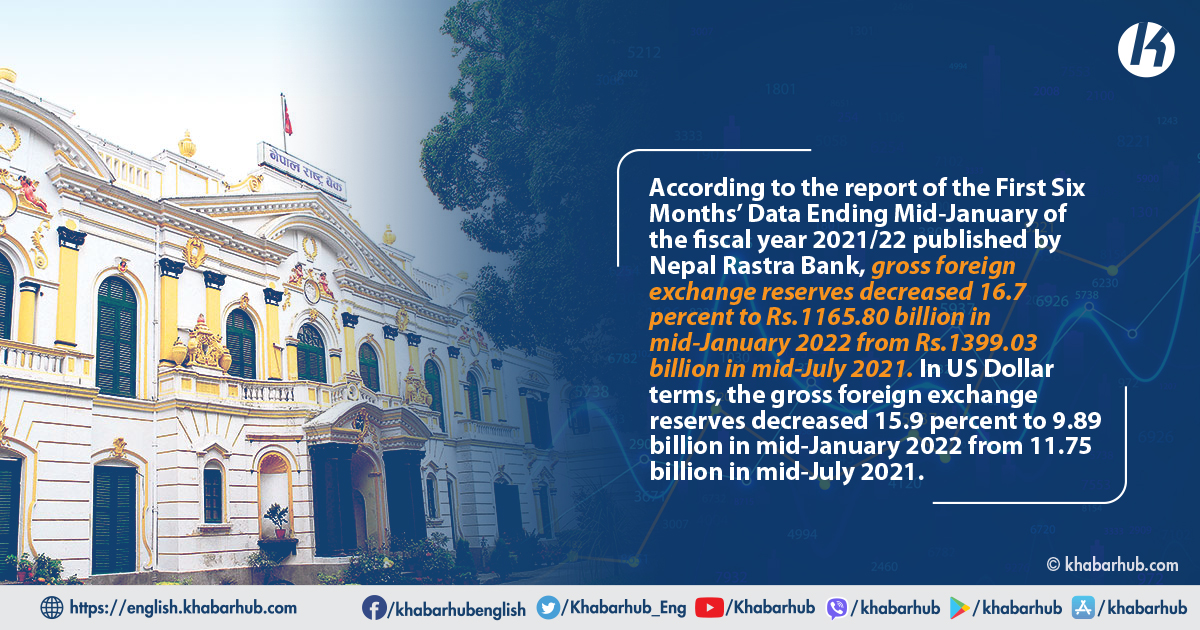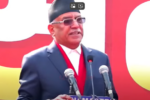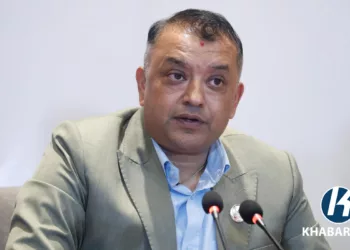KATHMANDU: The recent high imports and the decrease in foreign exchange reserves indicate that Nepal’s economy is at an alarming stage.
According to the report of the First Six Months’ Data Ending Mid-January of the fiscal year 2021/22 published by Nepal Rastra Bank (NRB), the total trade deficit increased 46.6 percent to Rs. 880.49 billion during the six months of the fiscal year.
Such a deficit had contracted 5.8 percent in the corresponding period of the previous year. The export-import ratio increased to 11.9 percent in the review period from 9.2 percent in the corresponding period of the previous year. During the six months of 2021/22, merchandise imports from India by paying convertible foreign currency amounted to Rs.110.91 billion. Such amount was Rs.83.01 billion in the same period of the previous year.
However, in the review period, merchandise exports increased 95.5 percent to Rs.118.85 billion compared to an increase of 6.1 percent in the same period of the previous year. Destination-wise, exports to India and other countries increased 121.8 percent and 30.2 respectively whereas exports to China decreased 10.2 percent. Exports of palm oil, soyabean oil, oil cakes, juice, woolen carpets, among others, increased whereas exports of cardamom, tea, herbs, zinc sheet, wire, among others, decreased in the review period.
Similarly, merchandise imports increased 51.1 percent to Rs.999.34 billion against a decrease of 4.8 percent a year ago. Destination-wise, imports from India, China, and other countries increased 37.5 percent, 51.5 percent, and 98.2 percent respectively. Imports of petroleum products, medicine, crude palm oil, transport equipment, vehicle and other parts, crude soyabean oil, among others, increased whereas imports of M.S. billet, cement, pulses, molasses sugar, insecticides, among others, decreased in the review period.
According to economist Pramod Rijal, NRB has tightened its grip on imports and money could not circulate due to this policy. As Nepal is an import-oriented economy, the government was collecting revenue from imports, taxes, purchase, and sale of land and import of other commodities. However, he dubbed that Nepal’s economic situation has become more vulnerable after the government tightened its grip on imports.
However, Former Finance Secretary Rameshwor Khanal has projected that imports will be increased in the country as the local elections are approaching.
According to NRB, Gross foreign exchange reserves decreased 16.7 percent to Rs.1165.80 billion in mid-January 2022 from Rs.1399.03 billion in mid-July 2021. In US Dollar terms, the gross foreign exchange reserves decreased 15.9 percent to 9.89 billion in mid-January 2022 from 11.75 billion in mid-July 2021. Of the total foreign exchange reserves, reserves held by NRB decreased 18.4 percent to Rs.1015.59 billion in mid-January 2022 from Rs.1244.63 billion in mid-July 2021.

Reserves held by banks and financial institutions (except NRB) decreased 2.7 percent to Rs.150.21 billion in mid-January 2022 from Rs.154.39 billion in mid-July 2021. The share of Indian currency in total reserves stood at 24.5 percent in mid-January 2022.
Based on the imports of six months of 2021/22, the foreign exchange reserves of the banking sector are sufficient to cover the prospective merchandise imports of 7.2 months, and merchandise and services imports of 6.6 months. The ratio of reserves-to-GDP (previous fiscal year), reserves-to-imports, and reserves-to-M2 stood at 27.3 percent, 54.8 percent, and 22.0 percent respectively in mid-January 2022. Such ratios were 32.8 percent, 84.7 percent, and 27.1 percent respectively in mid-July 2021.
Former Finance Secretary Khanal said that the decline in foreign reserves in Nepal has led to a serious crisis in the country’s economy.
He is of the view that not only the government but all the political parties are responsible for ringing the bell in the country’s economy.
According to economist Dr Chandra Mani Adhikari, the reasons for the decline in foreign exchange reserve in the country are due to a decline in tourist arrivals, foreign aid, remittances, foreign investment, and higher imports than exports.
Likewise, remittance inflows decreased 5.5 percent to Rs.468.45 billion in the review period against an increase of 11.1 percent in the same period of the previous year.
In the US Dollar terms, remittance inflows decreased 6.2 percent to 3.93 billion in the review period against an increase of 6.7 percent in the same period of the previous year. 19. The number of Nepali workers (institutional and individual-new and legalized) taking approval for foreign employment increased significantly to 167,513 in the review period.
It had decreased 89.0 percent in the same period of the previous year. The number of Nepali workers (Renew entry) taking approval for foreign employment increased 298.1 percent to 130,212 in the review period.
It had decreased 75.5 percent in the same period of the previous year. 20. Net transfer decreased 4.9 percent to Rs.523.01 billion in the review period. Such a transfer had increased 8.9 percent in the same period of the previous year.
According to economist Rijal, the decline in remittance inflows is due to Nepalis investing in cryptocurrencies and also a vulnerable economic condition of the country where Nepalis go for foreign employment.
The current account remained at a deficit of Rs.354.07 billion in the review period compared to a deficit of Rs.51.68 billion in the same period of the previous year. In US Dollar terms, the current account registered a deficit of 2.97 billion in the review period compared to a deficit of 440.8 million in the same period last year. In the review period, capital transfer decreased 20.0 percent to Rs.5.48 billion while net foreign direct investment (FDI) increased 48.1 percent to Rs.11.34 billion. In the same period of the previous year, capital transfer and net FDI amounted to Rs.6.85 billion and Rs.7.66 billion respectively.
Balance of Payments (BOP) remained at a deficit of Rs.241.23 billion in the review period against a surplus of Rs.124.92 billion in the same period of the previous year. In the US Dollar terms, the BOP remained at a deficit of 2.02 billion in the review period against a surplus of 1.05 billion in the same period of the previous year.
Likewise, during the six months of 2021/22, the total expenditure of the federal government according to data of the Financial Comptroller General Office (FCGO), Ministry of Finance, stood at Rs.506.70 billion. The recurrent expenditure, capital expenditure, and financing expenditure amounted to Rs.406.41 billion, Rs.50.81 billion, and Rs.49.47 billion respectively in the review period. In the review period, revenue mobilization (including the amount to be transferred to provincial and local governments) stood at Rs.542.05 billion.
The tax revenue and non-tax revenue amounted to Rs.493.99 billion and Rs.48.06 billion respectively in the review period. 31. In the review period, domestic debt mobilization of the federal government amounted to Rs.6.0 billion through treasury bills.
Balance at various accounts of the GoN maintained with NRB remained Rs.277.82 billion (including Provincial government and Local Authorities Account) in mid-Jan 2022 compared to Rs.194.70 billion in mid-July 2021.
Furthermore, domestic credit increased 8.2 percent in the review period compared to an increase of 8.7 percent in the corresponding period of the previous year.
On y-o-y basis, domestic credit increased 26.6 percent in mid-January 2022. 38. Monetary Sector’s claims on the private sector increased 12.0 percent in the review period compared to an increase of 11.0 percent in the corresponding period of the previous year.
On y-o-y basis, such claims increased 27.4 percent in mid-January 2022.
In the review period, NRB mopped up Rs.60 billion liquidity of which Rs.28.35 billion was through reverse repo auction and Rs.31.65 billion through deposit collection. In the corresponding period of the previous year, it was Rs.241.34 billion liquidity of which Rs.89.54 billion was through reverse repo and Rs. 151.80 billion through deposit collection auction. 48.
NRB injected Rs.3366.96 billion liquidity of which Rs.323.85 billion was through a repo, Rs.27.22 billion through outright purchase, and Rs.3015.89 billion through standing liquidity facility (SLF). 49.
Similarly, NRB injected liquidity of Rs. 80.26 billion through the net sale of USD 667.4 million from the foreign exchange market. Liquidity of Rs. 251.02 billion was injected through the net purchase of USD 2.12 billion in the corresponding period of the previous year.
The NRB purchased Indian currency (INR) equivalent to Rs.260.07 billion through the sale of USD 2.18 billion in the review period. INR equivalent to Rs.241.31 billion was purchased through the sale of USD 2.04 billion in the corresponding period of the previous year.
The outstanding amount of refinancing provided by NRB remained Rs.158.38 billion in mid-January 2022.
Deposit and Credit of BFIs (y-o-y, Mid-Jan) Deposits of BFIs Private sector credit 8 52. As of mid-January 2022, the outstanding concessional loan is Rs.213.58 billion extended to 1,40,521 borrowers.
Of which, Rs.136.01 billion has been extended to 57,626 borrowers for selected commercial agriculture and livestock businesses.
Likewise, Rs. 73.85 billion loan has been extended to 80,061 women entrepreneurs. A total of 2,834 borrowers have been availed Rs. 3.72 billion concessional loans to other sectors.
Business continuity loan has been extended to the Covid-19 affected tourism, cottage, small and medium industries for payment of salaries to workers and employees in line with ‘Business Continuity Loan Procedure, 2020’. Under this provision, Rs. 1.13 billion loans have been approved as of mid-January 2022.
Likewise, the y-o-y consumer price inflation stood at 5.65 percent in the sixth month of 2021/22 compared to 3.56 percent a year ago.
Food and beverage inflation stood at 4.92 percent whereas non-food and service inflation stood at 6.23 percent in the review month.
The prices of ghee and oil; transportation; alcoholic drinks; tobacco products and pulses & legumes sub-categories rose 21.22 percent, 14.07 percent, 11.37 percent, 10.48 percent, and 9.22 percent respectively on a y-o-y basis. 3.
In the review month, the Kathmandu Valley, Terai, Hill, and Mountain witnessed 5.28 percent, 6.15 percent, 5.34 percent, and 5.22 percent inflation respectively. Inflation in these regions was 3.55 percent, 2.87 percent, 4.72 percent, and 3.38 percent respectively a year ago.
The y-o-y wholesale price inflation stood at 8.08 percent in the review month compared to 6.18 percent a year ago.
The y-o-y wholesale price of consumption goods, intermediate goods, and capital goods increased 9.10 percent, 7.67 percent, and 7.14 percent respectively.
The y-o-y wholesale price of construction materials increased 17.51 percent in the review month.
According to Adhikari, the economy has been on the way to collapse due to the rise in prices even in the Terai this time.
The reason for the grim scenario is due to the lack of good governance, inability of government to increase expenditure, lack of coordination among three tier of government, inability to create environment for domestic and foreign investment, and inability to make domestic production competitive, Adhikari told Khabarhub.









Comment